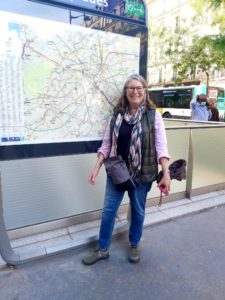 This month’s Author Interview is with Linda Elovitz Marshall, who’s a “writer of books for young children and other cool stuff.” I know her from a previous critique group and from Jane Yolen’s Picture Book Boot Camp. With all the success Linda’s having lately, it seems the right time to find out why.
This month’s Author Interview is with Linda Elovitz Marshall, who’s a “writer of books for young children and other cool stuff.” I know her from a previous critique group and from Jane Yolen’s Picture Book Boot Camp. With all the success Linda’s having lately, it seems the right time to find out why.
Let’s head right to the interview!
RVC: Let’s start with the Big News. You’ve got a new picture book coming out in a few days—Measuring a Year: A Rosh Hashanah Story. What’s the elevator pitch?
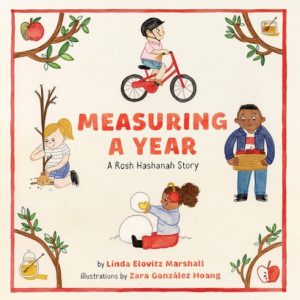 LM: No matter what you celebrate or how you count, every year has a beginning and an ending. Considering that the Jewish New Year–Rosh Hashanah–is a time of introspection, of looking inward, I wondered…How could anyone measure a year? Specifically, how could a CHILD measure a year?
LM: No matter what you celebrate or how you count, every year has a beginning and an ending. Considering that the Jewish New Year–Rosh Hashanah–is a time of introspection, of looking inward, I wondered…How could anyone measure a year? Specifically, how could a CHILD measure a year?
RVC: How did that story come about?
LM: I was sitting in the synagogue with my son and his family during a High Holiday service. When it was time for the sermon, the sanctuary became solemn, hushed. Cantor Jodi Schectman–who had only recently taken her position at Congregation Beth Emeth in Albany, New York–came to the bimah (the pulpit). She hummed a melody. I recognized the tune but couldn’t quite place it. She stopped humming and talked about changes in her life–selling her house in New Jersey, sending her youngest off to college, taking a new job in Albany. She hummed a few more bars. Then asked, rhetorically, “So, how DO you measure a year?” She described more changes in her life. Then she shared with the congregation that she’d been diagnosed with a Stage IV cancer. Once more, she asked, “How DO you measure a year?”
RVC: Wow.
LM: How DO you? I wondered. How does anyone? How does a child? What are the good things? The not-so-good? I wanted to take the lessons of Cantor Schectman’s powerful sermon…and share them with the world. And so I did. Measuring a Year: A Rosh Hashanah Story is dedicated to the memory of Cantor Jodi Schectman.
RVC: Measuring a Year is illustrated by Zara González Hoang. What did she bring to this powerful story?
LM: Zara’s beautiful illustrations brought much humor and warmth to the story. She also beautifully tied the text into the annual cycle of Jewish holidays.
RVC: Let’s circle back to the beginning. Rumor has it that you were speaking in full sentences before you were a year old. Reality or myth?
LM: It must be true. Why would I ever dispel such a myth? Truth is, I didn’t walk until I was almost two years old. Meanwhile, I listened and absorbed a lot. When I started talking, I had a lot to say.
RVC: When did you first discover you had a gift for writing?
LM: In fifth grade, I wrote a story about my new baby sister. My teacher suggested I might become a writer. But it wasn’t until decades later that I actually began writing professionally. In the interim, I had numerous careers, from owning a bookstore to capturing oral histories to raising sheep.
RVC: What kind of formal training did you have as a writer?
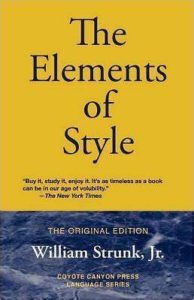 LM: None. However, I always read a lot. I’m also fortunate to have a good ear for language. Most importantly (and probably most under-rated), I had teachers who taught grammar. I highly recommend reading (and re-reading) The Elements of Style by Strunk and White. It’s a great handbook for writers.
LM: None. However, I always read a lot. I’m also fortunate to have a good ear for language. Most importantly (and probably most under-rated), I had teachers who taught grammar. I highly recommend reading (and re-reading) The Elements of Style by Strunk and White. It’s a great handbook for writers.
RVC: Since you’re a lover of words, it’s no surprise you ran your own bookshop. How did that happen?
LM: An opportunity came–and I grabbed it! That was shortly after I’d left my Ph.D. program in 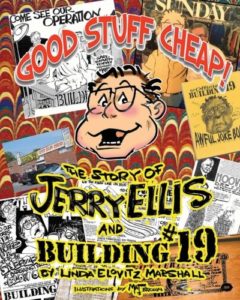 Anthropology. I still had children home and I was doing oral histories and writing articles for magazines (freelance). My bookstore began as a spinoff of my father’s bargain business (the late, great Building #19, Inc whose story is told in my self-published biography of my father, Good Stuff Cheap: The Story of Jerry Ellis and Building #19.)
Anthropology. I still had children home and I was doing oral histories and writing articles for magazines (freelance). My bookstore began as a spinoff of my father’s bargain business (the late, great Building #19, Inc whose story is told in my self-published biography of my father, Good Stuff Cheap: The Story of Jerry Ellis and Building #19.)
I soon transformed it into my own store–BOOKS FOR BEANS, INC. With a background in early childhood education, I specialized in books for teachers and children. And with my background in the bargain business, I made sure to sell good stuff, cheap!
RVC: What’s the story behind your first picture book sale?
LM: I was ringing the register in my bookstore when a customer said something that sparked an idea. That idea led to another idea…which led to another idea…and the idea of a story was born.
Eventually, I attended a conference for children’s book writers where I presented two manuscripts to an editor for critiques. She didn’t like either. I asked what she didn’t like about them. She told me. I listened. I revised, then sent the stories back to her with a note saying something like, “Thank you for helping me with these stories.” About a week later, that editor acquired both of my stories!
RVC: You’re well known for being a big-time reviser. What does your process look like?
LM: I try to listen…and learn. I want my words to flow, to sound beautiful. But more importantly, the story has to work. Sometimes, I share my works-in-progress with my critique groups. Sometimes, I don’t. I often show my work to my husband. He’s usually my very first reader…and he’s a very good one!
RVC: What’s your relationship with critique groups?
LM: I LOVE my critique groups. Right now, I’m in three, each with a different focus and style. I also enjoy critiquing privately. I served as Picture Book Mentor for my SCBWI chapter. In addition, I’m one of the Rate Your Story judges. I’m always delighted to work with new writers!
RVC: What can you tell us about the importance of community in a writer’s life?
LM: Community is so important, especially for writers. We give each other strength and buoy each other up when things are down. There are many times when things don’t go smoothly–when there’s rejection after rejection after rejection. Having a community of writers is a great balm. Sometimes, it’s even better than ice cream!
RVC: Complete the following sentence. “Linda Marshall is a writer who…”
LM: Linda Marshall is a writer who cares. She cares about accuracy, about kindness, about children, and about making the world a better place…in whatever way she can.
RVC: You have some clear throughlines in your picture books. What are those, and how important are they to you?
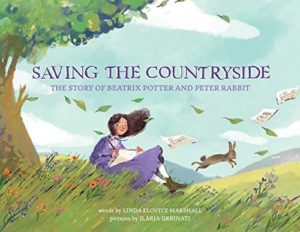 LM: My throughlines focus on things that are important to me–for example, the earth (see Saving the Countryside: The Story of Beatrix Potter and Peter Rabbit), public health (see The Polio Pioneer: Dr. Jonas Salk and the Polio Vaccine), and nature (see Good Night, Wind).
LM: My throughlines focus on things that are important to me–for example, the earth (see Saving the Countryside: The Story of Beatrix Potter and Peter Rabbit), public health (see The Polio Pioneer: Dr. Jonas Salk and the Polio Vaccine), and nature (see Good Night, Wind).
I put my heart into my writing…and try to make the world better.
RVC: Who sets the standard for nonfiction picture book writing?
LM: I learned about writing non-fiction picture books from the great editor Carolyn Yoder. She taught me to apply Ph.D.-quality research to my work for children. I love research–and I love her lesson! Thank you, again, Carolyn Yoder!
RVC: In all your experience as a picture book author, what has most surprised you?
LM: The children’s writing community is wonderfully kind and open. To my surprise, it’s made me kinder, too. I’m very grateful for that.
RVC: What’s your best tip for aspiring picture book writers?
LM: Read, read, read. Read GOOD stuff, stuff that makes you feel. Pay attention to the flow of words. Pay attention to your emotions. Pay attention to the world around. Feel. Be aware. And never lose your sense of wonder. Or your sense of possible. Or, of course, your sense of humor.
RVC: One last question for this part of the interview. It’s brag time! What cool new things should we expect from you in the future?
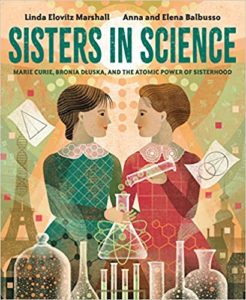 LM: In addition to Measuring a Year, I have several other books in the works. My forthcoming books include: Sisters in Science: Marie Curie, Bronia Dluska, and the Atomic Power of Sisterhood (Knopf, 2023), Bob Marshall: Defender of the Wilderness (South Dakota Historical Society, 2023), and Mexican Dreidel (KarBen/Lerner, 2023).
LM: In addition to Measuring a Year, I have several other books in the works. My forthcoming books include: Sisters in Science: Marie Curie, Bronia Dluska, and the Atomic Power of Sisterhood (Knopf, 2023), Bob Marshall: Defender of the Wilderness (South Dakota Historical Society, 2023), and Mexican Dreidel (KarBen/Lerner, 2023).
There’s one more but (shhh….) as of today, it’s not yet been announced.
RVC: Alright, Linda. It’s time for the SPEED ROUND. Fast questions followed by fast answers. Are you ready?
LM: Yes!
RVC: What is your biggest time waster?
LM: I check my email far too often. Hey, you never know when something good might pop in!
RVC: What animal or plant should be renamed?
LM: Shrub. What a yucky name! Like someone who can’t keep his pants up. You know, what a shrub that guy is…
RVC: You’re having a literary brunch. Which three writers (dead or alive) would you invite?
LM: Mark Twain, Sappho, and (of course) Jane Yolen.
RVC: What’s your favorite Jane Yolen picture book?
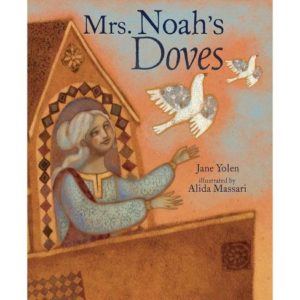 LM: No fair! That’s like asking which of my children is my favorite. I love Mrs. Noah’s Doves. It’s beautiful the way Jane Yolen spins a story–kind and sensitive and a bit magical. And, oh, her language! Pure poetry!
LM: No fair! That’s like asking which of my children is my favorite. I love Mrs. Noah’s Doves. It’s beautiful the way Jane Yolen spins a story–kind and sensitive and a bit magical. And, oh, her language! Pure poetry!
RVC: Five things you can’t do your job without?
LM: I need my computer (or a pen and paper), empty space to stare into, quiet, enthusiasm for my topic, and a bit of dark chocolate.
RVC: Best compliment a kid ever gave you (or your books)?
LM: The best–the absolute best–was when my husband overheard our grandson talking to his friends. One friend said his grandmother is a doctor, the other said his grandfather is a doctor. Our grandson proudly announced that his grandmother is a “writer…and she’s coming to our school!”
RVC: Thanks so much, Linda!

